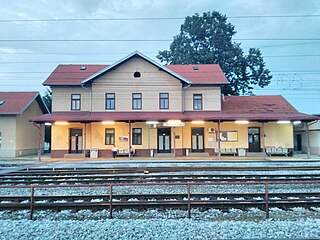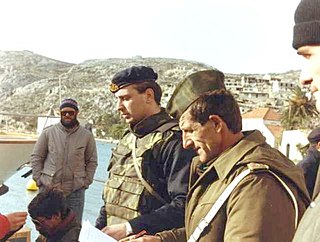Related Research Articles

Andrija Artuković was a Croatian lawyer, politician, and senior member of the ultranationalist and fascist Ustasha movement, who served as the Minister of Internal Affairs and Minister of Justice in the Government of the Independent State of Croatia (NDH) during World War II in Yugoslavia. He signed into law a number of racial laws against Serbs, Jews, and Roma, and was responsible for a string of concentration camps in which over 100,000 civilians were tortured and murdered. He escaped to the United States after the war, where he lived until extradited to Yugoslavia in 1986. He was tried and found guilty of a number of mass killings in the NDH, and was sentenced to death, but the sentence was not carried out due to his age and health. He died in custody in 1988.

Greater Croatia is a term applied to certain currents within Croatian nationalism. In one sense, it refers to the territorial scope of the Croatian people, emphasising the ethnicity of those Croats living outside Croatia. In the political sense, though, the term refers to an irredentist belief in the equivalence between the territorial scope of the Croatian people and that of the Croatian state.

Novska is a town in the Sisak-Moslavina County of Croatia. It is located in western part of the historic region of Slavonia, between Kutina and Nova Gradiška, 94 km (58 mi) linear distance southeast of the capital, Zagreb.
The Battle of Borovo Selo of 2 May 1991, known in Croatia as the Borovo Selo massacre and in Serbia as the Borovo Selo incident, was one of the first armed clashes in the conflict which became known as the Croatian War of Independence. The clash was precipitated by months of rising ethnic tensions, violence, and armed combat in Pakrac and at the Plitvice Lakes in March. The immediate cause for the confrontation in the heavily ethnic Serb village of Borovo Selo, just north of Vukovar, was a failed attempt to replace the Yugoslav flag in the village with the flag of Croatia. The unauthorised effort by four Croatian policemen resulted in the capture of two by a Croatian Serb militia in the village. To retrieve the captives, the Croatian authorities deployed additional police, who drove into an ambush. Twelve Croatian policemen and one Serb paramilitary were killed before the Yugoslav People's Army (JNA) intervened and put an end to the clashes.
The Vukovar massacre, also known as the Vukovar hospital massacre or the Ovčara massacre, was the killing of Croatian prisoners of war and civilians by Serb paramilitaries, to whom they had been turned over by the Yugoslav People's Army (JNA), at the Ovčara farm southeast of Vukovar on 20 November 1991, during the Croatian War of Independence. The massacre occurred shortly after Vukovar's capture by the JNA, Territorial Defence (TO), and paramilitaries from neighbouring Serbia. It was the largest massacre of the Croatian War of Independence.
The Lora prison camp was a prison camp in Split, Croatia. It was active from 1992 to 1997 with mainly Serbian residents of Split and prisoners of war being imprisoned throughout the Croatian War of Independence. The camp was the site of human rights abuses resulting in a controversial trial, acquittal, retrial and conviction of prison guards.
Operation Swath-10 was a military offensive undertaken by the Croatian Army against the SAO Western Slavonia Territorial Defense Forces on Bilogora Mountain in western Slavonia. Occurring from 31 October to 4 November 1991, during the Croatian War of Independence, the operation was a Croatian victory and its success set the stage for follow-up advances by Croatian forces on Papuk Mountain in Operation Papuk-91 in late November and December. By the end of the year the HV gained control of Papuk, securing transport routes between eastern Slavonia and the rest of Croatia.
Operation Hurricane-91 was a military offensive undertaken by the Croatian Army against the Yugoslav People's Army and SAO Western Slavonia Territorial Defense Forces in the Sava River valley, in the region of Western Slavonia during the Croatian War of Independence. The operation began on 29 October 1991 and ended on 3 January 1992 when a nationwide ceasefire was signed to implement the Vance plan. The offensive was aimed at recapturing the region, in conjunction with two other HV offensives launched against SAO Western Slavonia in the north of the region within days.
The Lovas killings involved the killing of 70 Croat civilian residents of the village of Lovas between 10 and 18 October 1991, during the Croatian War of Independence. The killings took place during and in the immediate aftermath of the occupation of the village by the Yugoslav People's Army (JNA) supported by Croatian Serb forces and Dušan the Mighty Forces. On 10 October, two days after Croatia declared independence from Yugoslavia. The occupation occurred during the Battle of Vukovar, as the JNA sought to consolidate its control over the area surrounding the city of Vukovar. The killings and abuse of the civilian population continued until 18 October, when troops guarding a group of civilians forced them to walk into a minefield at gunpoint and then opened fire upon them.
The Voćin massacre was the killing of 43 civilians in Voćin, Croatia, by the Serbian White Eagles paramilitary unit on 13 December 1991, during the Croatian War of Independence. The massacre was carried out after the unit was ordered to abandon the village before the Croatian Army recaptured the area in Operation Papuk-91. All the victims were local Croats, save one Serb, who had tried to protect his neighbours. Gunfire was the leading cause of death, though some of the victims were killed with axes or chainsaws, or were burned to death. The victims exhibited signs of torture and were left unburied. On the night of 13–14 December, the White Eagles dynamited a 550-year-old church in the village.

The Battle of Gospić was fought in the environs of Gospić, Croatia, from 29 August until 22 September 1991 during the Croatian War of Independence. The battle pitted the Yugoslav People's Army (JNA), stationed in five barracks in the town, and paramilitary elements of the Serbian Guard against the Croatian National Guard (ZNG), police forces based in Gospić and police reinforcements from elsewhere in Croatia. Fighting in the eastern districts of Gospić, controlled by JNA forces with supporting artillery, was largely static but the balance shifted in favor of the Croatian forces following the capture of several JNA depots and barracks on 14 September. The remaining barracks were captured by 20 September leading to the expulsion of the JNA and Serbian Guard forces from the town.

Kerestinec concentration camp was a prison that served as a concentration camp in Kerestinec, Independent State of Croatia during World War II. It was located in the Erdödy castle overlooking the village.
The Trial of Gotovina et al. was a war crimes trial held from March 2008 until November 2012 before the International Criminal Tribunal for the former Yugoslavia (ICTY), set up in 1993. The ICTY indicted Croatian Army (HV) generals Ante Gotovina, Ivan Čermak, and Mladen Markač for war crimes, specifically for their roles in Operation Storm, citing their participation in a joint criminal enterprise (JCE) aimed at the permanent removal of Serbs from the Republic of Serbian Krajina (RSK) held part of Croatia.

The 1991 Yugoslav campaign in Croatia was a series of engagements between the Yugoslav People's Army (JNA), the Yugoslav Navy and the Yugoslav Air Force, and the Croatian National Guard (ZNG) then the Croatian Army (HV) during the Croatian War of Independence. The JNA was originally deployed in order to preserve Yugoslavia, and the initial plan of the campaign entailed the military occupation of Croatia and the removal of the Croatian leadership elected in 1990. The JNA intervention was the culmination of its involvement in the confiscation of weapons from Croatia's Territorial Defence, and in the Croatian Serb revolt that had begun in August 1990. From that time, the JNA had been frequently deployed to form a buffer zone between the Croatian Serb guerrillas and the ZNG or the Croatian police. In effect, these JNA buffer zones often secured the territorial gains of the insurgents and led to an increasingly hostile relationship between the JNA and Croatia. The JNA campaign plan was amended shortly before the campaign to include the relief of JNA barracks besieged by the ZNG. The besieging and subsequent capture of several JNA facilities allowed Croatia to arm its previously poorly equipped military and to equip and recruit new ethnic Croat conscripts and officers of the Yugoslav People's Army.
The Grubori massacre was the mass murder of six Serb civilians from the village of Grubori, near Knin, on 25 August 1995 by members of the Croatian Army (HV) in the aftermath of Operation Storm. The massacre was listed in the ICTY's indictment of Croatian wartime generals Ante Gotovina, Ivan Čermak and Mladen Markač.
The Sisak killings refers to the illegal detainment, torture and murder of Croatian Serb civilians from the city of Sisak by members of the Croatian Army and police from July 1991 to June 1992 during the Croatian War of Independence.
The Marino Selo camp was a makeshift prison camp located on the premises of the fishing hut in the village of Marino Selo where Croatian Serb civilians were detained, tortured and killed by members of the 76th Independent Battalion Croatian National Guard (ZNG).
Thirteen Yugoslav People's Army prisoners of war were extrajudicially killed at the Korana bridge in Karlovac, Croatia on 21 September 1991, during the Croatian War of Independence. Four others survived the massacre, two of whom sustained injuries.
The Berak killings was the mass murder of Croat civilians by Serb rebels and paramilitaries from September until December 1991, in the village of Berak, near Vukovar, during the Croatian War of Independence.
References
- ↑ Lobell, Steven; Mauceri, Philip (2004). Ethnic Conflict and International Politics: Explaining Diffusion and Escalation. Springer. pp. 79–81. ISBN 978-1-40398-141-7.
- ↑ Sudetic, Chuck (2 April 1991). "Rebel Serbs Complicate Rift on Yugoslav Unity". The New York Times.
- ↑ Psaltis, Charis; Carretero, Mario; Čehajić-Clancy, Sabina (2017). History Education and Conflict Transformation: Social Psychological Theories, History Teaching and Reconciliation. Springer. p. 106. ISBN 978-3-31954-681-0.
- 1 2 3 4 5 6 "Novska". snv.hr. Serb National Council.
- 1 2 3 4 "Slowness of the judiciary and additional victimization of the casualties – 20 years from war crime in Novska". documenta.hr. Documenta – Center for Dealing with the Past. 3 July 2012.
- ↑ Marijan 2012a , p. 110
- 1 2 3 4 Pavelic, Boris (12 March 2012). "War Victims in Croatia Punished by Courts". Balkan Investigative Reporting Network.
- 1 2 Pavelic, Boris (8 March 2013). "Croatian Soldiers Acquitted of Murdering Serbs". Balkan Investigative Reporting Network.
- ↑ "30 godina od ubojstva Mihajla Šeatovića, supružnika Rašković i Ljubana Vujića". documenta.hr (in Croatian). Documenta – Center for Dealing with the Past. 21 November 2021.
- 1 2 Pavelic, Boris (11 March 2013). "Croatian Soldiers Jailed for Killing Serb Women". Balkan Investigative Reporting Network.